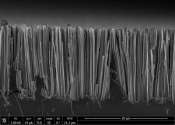Computers made of genetic material? Researchers conduct electricity using DNA-based nanowires
Tinier than the AIDS virus—that is currently the circumference of the smallest transistors. The industry has shrunk the central elements of their computer chips to fourteen nanometers in the last sixty years. Conventional ...








